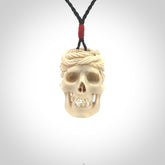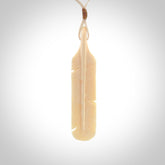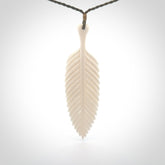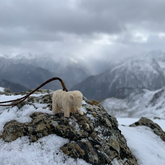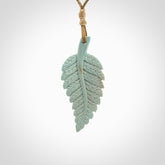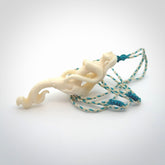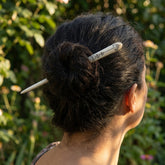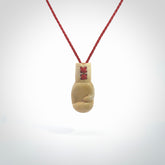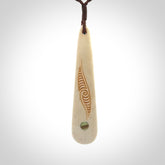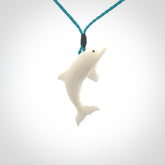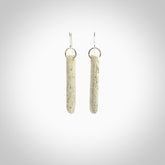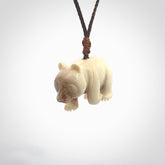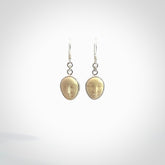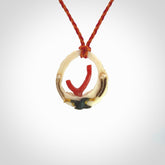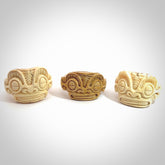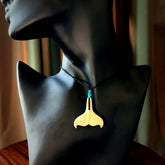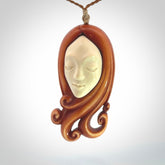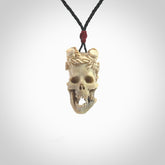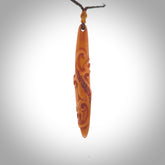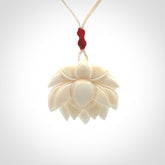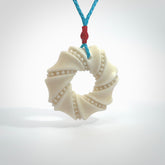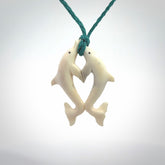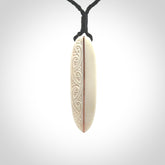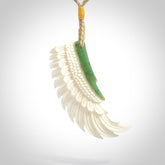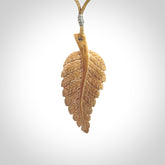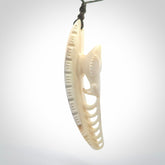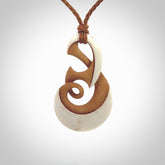Filter
249 results
Featured
- Featured
- Best selling
- Alphabetically, A-Z
- Alphabetically, Z-A
- Price, low to high
- Price, high to low
- Date, old to new
- Date, new to old
Sort
Sort by:
- Featured
- Best selling
- Alphabetically, A-Z
- Alphabetically, Z-A
- Price, low to high
- Price, high to low
- Date, old to new
- Date, new to old
-
SWASHBUCKLERVendor: NZ PacificSWASHBUCKLER - skull pendant, hand carved in deer antler Carved from solid deer antler, our SWASHBUCKLER pendant is a tribute to the daring spirit. It centres on a meticulously detailed skull - a timeless memento mori - enshrouded with hair intricately woven like maritime rope....
- $260.00 AUD
- $260.00 AUD
- Unit price
- / per
-
DREAMCATCHERVendor: NZ PacificDREAMCATCHER - a phenomenal carving of two wondrous sea creatures, one legendary, the other a favourite of people in all corners of the earth. A dolphin and a mermaid joined together in a mythical dance. DREAMCATCHER is a gorgeous piece, carved in bone for us by...
- $862.00 AUD
- $862.00 AUD
- Unit price
- / per
-
GOLDEN EAGLEVendor: NZ PacificGOLDEN EAGLE - hand carved feather from woolly mammoth tusk A gorgeous material from the long extinct Woolly Mammoth - reborn in these awesome feather pendants. We have modelled this design on the Golden Eagle - a magnificent bird of prey that roams the Northern...
- $215.00 AUD
- $215.00 AUD
- Unit price
- / per
-
WINDBREAKVendor: NZ PacificWINDBREAK A large fern leaf pendant, hand carved in Bone. In Japanese culture ferns represent family. The leaves are stronger together and they protect one another. WINDBREAK is a wonderful gift for someone you love! Delivered to you on a khaki coloured adjustable cord. WINDBREAK...
- $137.00 AUD
- $137.00 AUD
- Unit price
- / per
-
FORTY WINKSVendor: NZ PacificFORTY WINKS - a lovely piece of wearable art for ornithologists and lovers of the exotic! FORTY WINKS is a magnificent piece, hand carved from cow bone. The eyes are made from goat horn. This piece was carved for us by Fumio Noguchi. He has...
- $687.00 AUD
- $687.00 AUD
- Unit price
- / per
-
MASTODONVendor: NZ PacificMASTODON - They're back .... We have made a hand carved Woolly Mammoth pendant - from genuine fossilised, woolly mammoth tusk. This is a beautiful little pendant with lots of character - a fabulous and very unique gift. The Mammoth Tusk used for this...
- $307.00 AUD
- $307.00 AUD
- Unit price
- / per
-
BLUE WHISPERVendor: NZ PacificMammoth Tusk - Fantastic Grain, Wonderful Colours... every piece unique! BLUE WHISPER - hand carved from mammoth tusk, an ancient material from the long extinct Woolly Mammoth brought back to life in these delicate little hand carved fern pendants. These are a gorgeous blue...
- $215.00 AUD
- $215.00 AUD
- Unit price
- / per
-
MOANA'S PARADISEVendor: NZ PacificMOANA'S PARADISE - with her head held high and a song sung true. It is MOANA'S PARADISE that calls to you. Hand carved in bone by Yuri Terenyi, this is an outstanding little work of art. Detailed and wonderfully expressive - a siren of the sea...
- $792.00 AUD
- $792.00 AUD
- Unit price
- / per
-
STAR REACHERVendor: NZ PacificSTAR REACHER - hand Carved Bone Hair Pin Made by Amanda Thompson.. this is a beautiful and fully functional hairpin - made to be worn! This gorgeous hair pin has a double sided koru design etched and inked into the bone - whichever way...
- $263.00 AUD
- $263.00 AUD
- Unit price
- / per
-
THE BUTTERFLY AND THE BEEVendor: NZ PacificA piece we've carved with all those great boxers in mind - Ali, Big George, Floyd, Smoking Joe..... to name a few. This is a quirky piece, beautifully carved, bound and ready to wear. Three Options: BUTTERFLY - Bound with a Pohutukawa Red Neck Cord BEE -...
- $159.00 AUD
- $159.00 AUD
- Unit price
- / per
-
TE HAERENGA KI TE KAINGAVendor: NZ PacificTE HAERENGA KI TE KAINGA - a beautifully carved, stained drop for lovers of unique art to wear! Hand carved for us by Andrew Doughty. TE HAERENGA KI TE KAINGA - the journey home. An exceptionally beautiful, reversible pendant that is destined to become...
- $421.00 AUD
- $421.00 AUD
- Unit price
- / per
-
POPOTO - MAUI DOLPHINVendor: NZ PacificPOPOTO - Maui Dolphin Pendant, Hand Carved in Bone We have made POPOTO in recognition of the world's smallest and rarest dolphin - the MAUI. This little guy is only found off the West Coast of New Zealand's North Island and is at risk...
- $87.00 AUD
- $87.00 AUD
- Unit price
- / per
-
SALTWATER SKINVendor: NZ PacificSALTWATER SKIN With lovers of the sea in mind! Beautifully handcrafted, these SALTWATER SKIN earrings are made from Whalebone. Wonderful Art to Wear, lovingly packaged in a woven kete pouch. Perfect for any occasion, they offer a unique and fascinating look. We're thrilled to have these on...
- $225.00 AUD
- $225.00 AUD
- Unit price
- / per
-
TRAIL BLAZERVendor: NZ PacificTRAIL BLAZER - on his journey with humour and determination... A hand carved Bear pendant made from Deer Antler. These are beautifully carved and modelled on a Panda Bear. The carving is exquisite and crafted with lovely attention to detail - have a look...
- $298.00 AUD
- $298.00 AUD
- Unit price
- / per
-
PEACEFUL REFLECTIONVendor: NZ PacificPEACEFUL REFLECTION Hand carved moon face earrings made from Woolly Mammoth tusk. A very special piece of ancient tusk handcrafted into attractive and unique earrings. The Mammoth Tusk used for this piece is CERTIFIED 34,690 YEARS OLD (+/- 815 years). All our Woolly Mammoth pieces are...
- $168.00 AUD
- $168.00 AUD
- Unit price
- / per
-
CORAL HUIVendor: NZ PacificCORAL HUI - detailed and expressive, this is a rare and beautiful piece of hand carved jewellery. Sami has crafted a piece that is simply beautiful. Carved from Deer Antler with Red Coral, CORAL HUI is an outstanding piece of Art to Wear! Owning a unique piece...
- $508.00 AUD
- $508.00 AUD
- Unit price
- / per
-
MELLOW IN MAMMOTHVendor: NZ PacificMELLOW IN MAMMOTH Our MELLOW IN MAMMOTH ring is perfect for those who like to keep things chill... hand carved from ancient Woolly Mammoth Tusk, MELLOW IN MAMMOTH is a delight to wear. We've got your finger art covered! We lovingly package MELLOW IN MAMMOTH...
- $234.00 AUD
- $234.00 AUD
- Unit price
- / per
-
KAIORAVendor: NZ PacificKAIORA - Majestic Original 'art to wear' from Andrew Doughty. Andrew has named this beautiful little whale tail pendant KAIORA, which means majestic. We will include a lengthy description of this piece - detail on the meaning behind the detail in the carving...
- $326.00 AUD
- $326.00 AUD
- Unit price
- / per
-
SLEEPING BEAUTYVendor: NZ PacificSLEEPING BEAUTY This is a piece for someone who loves striking, original Art to Wear! SLEEPING BEAUTY is a gorgeous piece carved from an amalgam of materials. The hair is carved from bone and stained a copper brown using homemade dye. The face is carved...
- $1,056.00 AUD
- $1,056.00 AUD
- Unit price
- / per
-
LOST BUCCANEERVendor: NZ PacificLOST BUCCANEER - Hand carved from Deer Antler, an expressive skull pendant. We have two options available; please use the drop-down menu to make your selection. The skull is an ancient symbol that has long been adopted to evoke a host of strong emotional...
- $260.00 AUD
- $260.00 AUD
- Unit price
- / per
-
THE THINKERVendor: NZ PacificTHE THINKER - This is a wonderful carving - a lizard form carved in relief on a bone drop. It's fanciful - the lizard has two tails, one side is crawling up the pendant and the other back down. Yuri has stained this piece...
- $302.00 AUD
- $302.00 AUD
- Unit price
- / per
-
EVERLASTINGVendor: NZ PacificEVERLASTING - a lovely double twist pendant carved from natural bone. This is a graceful representation of a carving which symbolises friendship, partnership and love. The twist: symbol of friendship, partnership and loyalty We will also include one of our 'Kia Ora' cards, which explains...
- $98.00 AUD
- $98.00 AUD
- Unit price
- / per
-
PRECIOUS LOTUSVendor: NZ PacificPRECIOUS LOTUS - carved in bone. The PRECIOUS LOTUS grew from the mud... and blossomed! This piece is a wonderful example of the beauty of hand carved jewellery. A lotus flower unlike any you have ever seen before, hand carved from a piece of natural bone. PRECIOUS LOTUS is...
- $165.00 AUD
- $165.00 AUD
- Unit price
- / per
-
CORONETVendor: NZ PacificCORONET - Hand carved bone pendant This is a remarkable piece. We can't speak highly enough about the craftsmanship required to carve a piece like this. It falls beautifully, and looks deceptively simple. In reality it is very complex - very few people would...
- $431.00 AUD
- $431.00 AUD
- Unit price
- / per
-
THE RENDEZVOUSVendor: NZ PacificTHE RENDEZVOUS A meeting of two dolphins, a lovely little carving ready to swim home! THE RENDEZVOUS - Hand carved from natural bone, an elegant, playful pendant for dolphin and ocean lovers alike! We have also made a very brief video of these lovers slowly revolving -...
- $104.00 AUD
- $104.00 AUD
- Unit price
- / per
-
KĀHUARAUVendor: NZ PacificKĀHUARAU - a beautifully carved, drop pendant for all you lovers of art to wear! Hand carved by Andrew Doughty. In the artists words below... This small taonga is named Kāhuarau which means metamorphosis. In the centre of the bone is an inlay of copper....
- $395.00 AUD
- $395.00 AUD
- Unit price
- / per
-
WINGED SPIRITVendor: NZ PacificWINGED SPIRIT - This is an experimental piece combining Jade and Bone - a WINGED SPIRIT to inspire you to reach for the sky, take a chance and learn to fly! A fun, hand made piece of Art to Wear. WINGED SPIRIT can be worn...
- $263.00 AUD
- $263.00 AUD
- Unit price
- / per
-
WHISPERVendor: NZ PacificWHISPER - Gorgeous, hand-carved Woolly Mammoth Tusk fern leaf pendants. The Mammoth Tusk used for this piece is CERTIFIED 34,690 YEARS OLD (+/- 815 years). All our Woolly Mammoth pieces are provided with our certificate of authenticity. We had our mammoth material carbon dated to get...
- $171.00 AUD
- $171.00 AUD
- Unit price
- / per
-
CHEVRONED AMULETVendor: NZ PacificCHEVRONED AMULET is rather unique. Carved for us by Yuri Terenyi, it is based on a very old style design that was carved by Māori many years ago. The chevron design was found incorporated in quite a number of designs, and combined with the bird,...
- $1,052.00 AUD
- $1,052.00 AUD
- Unit price
- / per
-
JOURNEY ONVendor: NZ PacificJOURNEY ON - an intricate and eye-catching complex bone twist pendant Complex and beautiful, the carving twists and turns with grace and unity. Amanda has used a natural white bone, polished to a beautiful bright finish. The intertwined carved centre is stained in a...
- $550.00 AUD
- $550.00 AUD
- Unit price
- / per






































































































